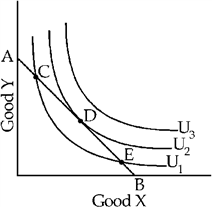"Every point on a demand curve represents a consumer equilibrium in the indifference curve model." Explain why the previous statement is correct or not
What will be an ideal response?
The statement is correct. The demand curve is derived using the indifference curve/budget line diagram. Hence every point on the demand curve is the result of a consumer equilibrium in the indifference curve/budget line diagram.
You might also like to view...
Which of the following is not the result of wage stickiness in an economic downturn?
A. Actual wages are temporarily above the market-clearing level. B. Cyclical unemployment. C. A surplus of labor. D. A shortage of labor.
Assume that the central bank lowers the discount to increase the nation's monetary base. If the nation has highly mobile international capital markets and a fixed exchange rate system, what happens to the quantity of real loanable funds per time period and the nominal value of the domestic currency in the context of the Three-Sector-Model? State your answer after the macroeconomic system returns
to complete equilibrium. a. The quantity of real loanable funds per time period rises and nominal value of the domestic currency remains the same. b. The quantity of real loanable funds per time period falls and nominal value of the domestic currency remains the same. c. The quantity of real loanable funds per time period and nominal value of the domestic currency remain the same. d. The quantity of real loanable funds per time period rises and nominal value of the domestic currency rises. e. There is not enough information to determine what happens to these two macroeconomic variables.
When the Fed increases the money supply, the interest rate decreases. This decrease in the interest rate increases consumption and investment demand, so the aggregate-demand curve shifts to the right
a. True b. False Indicate whether the statement is true or false
Figure 5-13

In Figure 5-13, the slope of the budget line (dropping all minus signs) equals
a.
price of good X/price of good Y.
b.
price of good Y/price of good X.
c.
the minimum number of units of good Y the consumer would have to receive to make him willing to give up one unit of good X.
d.
the minimum number of units of good X the consumer would have to receive to make him willing to give up one unit of good Y.